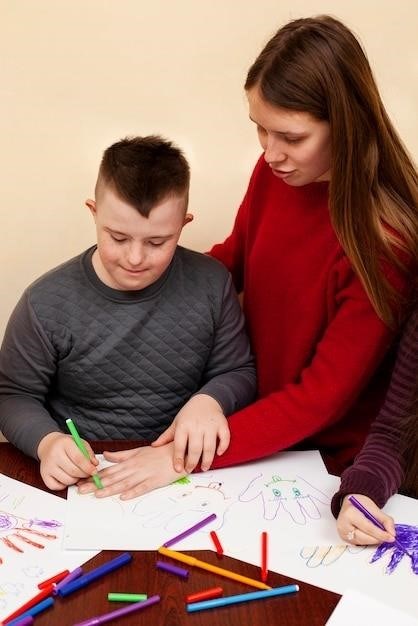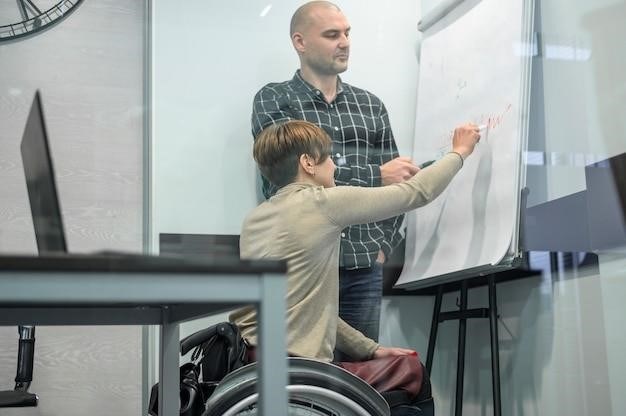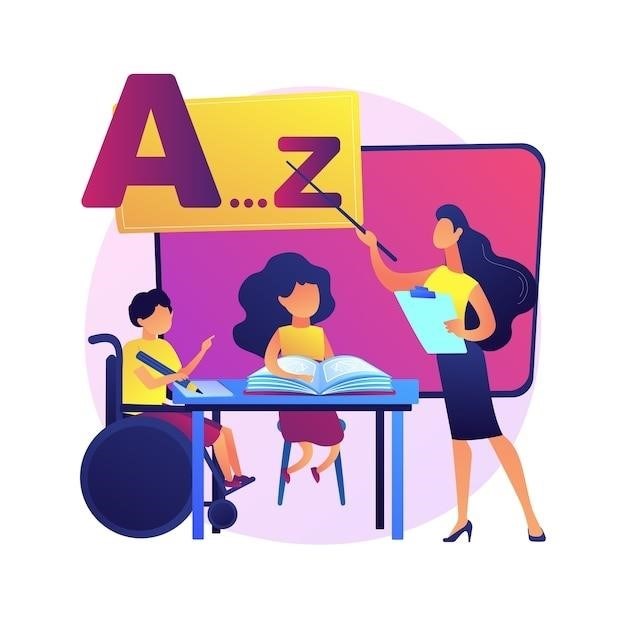Understanding Special Education Law and Processes
This practical reference clarifies what general education teachers need to know about special education law and processes and provides a guide to instructional best practices for the inclusive classroom․
The Individuals with Disabilities Education Act (IDEA)
The Individuals with Disabilities Education Act (IDEA) is the federal law that governs special education in the United States․ It ensures that all children with disabilities have access to a free and appropriate public education (FAPE), regardless of the severity of their disability․ IDEA requires that schools develop Individualized Education Programs (IEPs) for each student with a disability, outlining their educational needs and how those needs will be met․ General education teachers play a crucial role in the IEP process, collaborating with special education teachers and parents to develop and implement individualized plans for their students․
The Every Student Succeeds Act (ESSA)
The Every Student Succeeds Act (ESSA) is a recent piece of legislation that reauthorizes the Elementary and Secondary Education Act (ESEA)․ ESSA emphasizes the importance of high-quality instruction, accountability, and collaboration among educators․ It requires states to develop plans for improving educational outcomes for all students, including those with disabilities․ ESSA also promotes the use of evidence-based practices and encourages schools to implement inclusive practices that support the needs of all learners․
Section 504 of the Rehabilitation Act
Section 504 of the Rehabilitation Act of 1973 is a civil rights law that prohibits discrimination against individuals with disabilities․ It applies to any program or activity that receives federal funding, including schools․ Under Section 504, schools must provide reasonable accommodations to students with disabilities to ensure they have equal access to education․ This may include modifications to curriculum, assistive technology, or changes to the learning environment․
The Role of the General Education Teacher
General education teachers play a crucial role in creating inclusive learning environments for all students, including those with disabilities․
Collaboration with Special Education Professionals
Effective collaboration between general and special education teachers is essential for providing appropriate support and instruction to students with disabilities․ This collaboration ensures a cohesive approach to meeting individual student needs, with both educators sharing expertise and working together to create a seamless learning experience․
Implementing Individualized Education Programs (IEPs)
General education teachers play a crucial role in implementing IEPs․ They must understand the specific goals and objectives outlined in the IEP and provide appropriate accommodations and modifications to ensure the student’s success․ Regular communication with special education professionals is vital to ensure the IEP is being implemented effectively and to adjust strategies as needed․
Providing Accommodations and Modifications
Accommodations and modifications are essential for creating an inclusive learning environment for students with disabilities․ Accommodations adjust how a student learns, such as providing assistive technology or extended time on assignments․ Modifications change what a student is expected to learn, such as simplifying instructions or providing alternative assessments․

Instructional Best Practices for Inclusive Classrooms
This section explores strategies for creating inclusive classrooms that cater to the diverse needs of all students․
Differentiated Instruction
Differentiated instruction is a teaching approach that acknowledges the diverse learning styles and needs of students․ It involves tailoring instruction, materials, and assessments to meet the individual needs of each learner․ This can include providing different levels of support, varying the complexity of tasks, and offering a range of learning activities to engage students with diverse interests and abilities․
Universal Design for Learning (UDL)
Universal Design for Learning (UDL) is a framework that promotes accessibility and inclusivity in education․ It focuses on creating learning environments that are flexible and adaptable to meet the diverse needs of all learners․ UDL principles emphasize providing multiple means of representation, engagement, and action and expression, ensuring that all students have equal opportunities to access and demonstrate their learning․
Positive Behavior Supports
Positive behavior supports (PBS) are a proactive approach to creating a positive and productive learning environment․ They involve identifying and addressing the root causes of challenging behaviors, teaching appropriate social skills, and providing students with positive reinforcement for desired behaviors․ Effective PBS strategies can help reduce disruptive behaviors, promote a sense of belonging, and create a more inclusive classroom for all learners․
Supporting Students with Specific Disabilities
This section explores strategies for supporting students with various disabilities, including learning disabilities, emotional and behavioral disorders, and physical disabilities․
Students with Learning Disabilities
Students with learning disabilities may struggle with reading, writing, math, or other academic skills․ Teachers can provide support by using differentiated instruction, providing accommodations, and collaborating with special education professionals to create individualized learning plans․
Students with Emotional and Behavioral Disorders
Students with emotional and behavioral disorders may exhibit challenging behaviors, such as aggression, defiance, or withdrawal․ Teachers can support these students by implementing positive behavior supports, providing a structured and predictable classroom environment, and collaborating with school counselors or psychologists․
Students with Physical Disabilities
Students with physical disabilities may require accommodations such as adapted seating, assistive technology, or modifications to classroom activities․ Teachers should work closely with the student’s Individualized Education Program (IEP) team to ensure appropriate supports are in place and that the student can fully participate in the classroom environment․

Resources for General Education Teachers
General education teachers have access to a variety of resources to support them in working with students with disabilities․
Professional Development Opportunities
Professional development opportunities are essential for general education teachers to gain the knowledge and skills needed to effectively support students with disabilities․ These opportunities can be provided through workshops, conferences, online courses, and mentoring programs․ They often focus on topics such as understanding special education law, implementing individualized education programs (IEPs), and using differentiated instruction and assistive technology․
Online Resources and Support Networks
The internet offers a wealth of resources for general education teachers seeking information and support related to special education․ Websites like the National Center for Learning Disabilities, the Council for Exceptional Children, and the U․S․ Department of Education provide comprehensive information on special education laws, best practices, and available resources․ Online support networks, such as teacher forums and social media groups, offer a space for teachers to connect, share experiences, and seek advice from colleagues․
Collaboration with Special Education Teachers
Effective collaboration between general and special education teachers is crucial for providing a high-quality education for all students․ Regular communication, shared planning, and co-teaching opportunities allow teachers to coordinate strategies, share expertise, and ensure that students’ individual needs are met․ This collaboration fosters a supportive environment where both teachers and students can thrive․
Creating an Inclusive Classroom Environment
Creating a welcoming and supportive atmosphere for all students is essential for fostering a sense of belonging and promoting academic success․
Building Relationships with Students
Take the time to get to know each student individually, considering their strengths, interests, and learning styles․ Engage in meaningful conversations, show genuine interest in their lives, and create opportunities for positive interactions․ Building strong relationships fosters trust, respect, and a sense of belonging, which are crucial for supporting all students, especially those with disabilities․
Promoting Positive Social Interactions
Create opportunities for students to interact with each other in meaningful ways․ Encourage cooperative learning activities, group projects, and social events that promote teamwork, communication, and empathy․ Model respectful behavior and teach social skills explicitly, providing students with the tools they need to navigate social situations effectively․
Creating a Welcoming and Supportive Atmosphere
Establish a classroom environment that is physically and emotionally safe for all students․ Decorate the classroom with inclusive themes, incorporate diverse perspectives in your curriculum, and celebrate individual differences․ Promote a culture of respect, kindness, and acceptance, where students feel valued and supported․ This can be achieved through positive reinforcement, clear expectations, and open communication․
